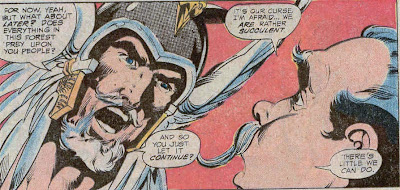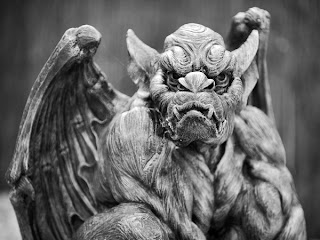Warlord (vol. 1) #46 (June 1981)
Written and Illustrated by Mike Grell; inked by Romeo Tanghal
Synopsis: Morgan, Aton, and Shakira arrive at the coast at the wreck of the Lady J, Jennifer Morgan’s ship. Morgan says they should split up to search for her, Aton going south, and Morgan and Shakira, north. If either finds her, alive or dead, they plan to bring her to Shamballah.
Morgan gallops off, and as Aton watches him go he pities his leader for the hardships the fates have brought him. What Aton doesn’t know is that Morgan's restless, warrior’s heart relishes this--the dangers and challenges to come...
Morgan is briefly unconscious, but as he awakens in a daze, he sees his old friend--sexy, personified Death--in front of him:
Morgan follows her gesture and sees Shakira (in cat form) lying apparently lifeless! Morgan cries out in denial as he sees Shakira's human spirit rise to follow Death. He staggers to his feet to go after them. He calls to his friend, but she doesn’t heed him. They pass through doors in the mouth of a cave, emblazoned with the legend: “Abandon All Hope Ye Who Enter Here.”
Morgan follows without hesitation. His mind reels as he enters a a subterranean realm of evil where demonic beings use humans as play things. He hesistates only a moment before following his companion’s path.
The doors slam shut behind him, and Morgan is accosted by the shades of previous enemies--Shebal, Stryker, and Chakal in the fore. They’ve been awaiting for Morgan. Waiting for revenge.
Morgan doesn’t waste time fighting the already dead. He takes a leap of faith into the pit of flame below while calling out Death’s name: “Azrael!” She hears him:
Morgan demands she return Shakira. Death calls him “my love” and declares him a faithful servant, but denies him. He bargains with her, offering his life in exchange. Again Death denies him, saying he serves her too well to take now, but she gives a counter-offer: ten years off his life is her price.
Morgan agrees. Death strikes him, causing a scar like a Roman numeral ten to appear on his breast--a symbol of their deal.
She shows him Shakira in the grip of a serpentine demon, and says: “Save her if you can.”
Morgan jumps from her hand. He cuts down the demon, then takes up Shakira in his arms. Fighting of off more demons, he makes his way back to the great doors, barely ahead of his pursuers. Once through, he makes it back to his mount before collapsing.
He awakens with Shakira’s hand on his shoulder. She’s relieved he’s alive; she thought the lizard had killed him. Shakira remembers nothing of what happened, and Morgan might chalk it up to a blow to his head himself.
Except for the X-shaped scar in his chest.
Things to Notice:
Morgan gallops off, and as Aton watches him go he pities his leader for the hardships the fates have brought him. What Aton doesn’t know is that Morgan's restless, warrior’s heart relishes this--the dangers and challenges to come...
One of those dangers presents itself soon in the form of one of Skartaris’ orange carnosaurs. The beast charges. Morgan draws and fires right into its maw. The bullet blasts through its skull, killing it instantly, but its momentum sends it crashing into Morgan, Shakira, and their mount, toppling them all.
Morgan follows her gesture and sees Shakira (in cat form) lying apparently lifeless! Morgan cries out in denial as he sees Shakira's human spirit rise to follow Death. He staggers to his feet to go after them. He calls to his friend, but she doesn’t heed him. They pass through doors in the mouth of a cave, emblazoned with the legend: “Abandon All Hope Ye Who Enter Here.”
Morgan follows without hesitation. His mind reels as he enters a a subterranean realm of evil where demonic beings use humans as play things. He hesistates only a moment before following his companion’s path.
The doors slam shut behind him, and Morgan is accosted by the shades of previous enemies--Shebal, Stryker, and Chakal in the fore. They’ve been awaiting for Morgan. Waiting for revenge.
Morgan doesn’t waste time fighting the already dead. He takes a leap of faith into the pit of flame below while calling out Death’s name: “Azrael!” She hears him:
Morgan demands she return Shakira. Death calls him “my love” and declares him a faithful servant, but denies him. He bargains with her, offering his life in exchange. Again Death denies him, saying he serves her too well to take now, but she gives a counter-offer: ten years off his life is her price.
Morgan agrees. Death strikes him, causing a scar like a Roman numeral ten to appear on his breast--a symbol of their deal.
She shows him Shakira in the grip of a serpentine demon, and says: “Save her if you can.”
Morgan jumps from her hand. He cuts down the demon, then takes up Shakira in his arms. Fighting of off more demons, he makes his way back to the great doors, barely ahead of his pursuers. Once through, he makes it back to his mount before collapsing.
He awakens with Shakira’s hand on his shoulder. She’s relieved he’s alive; she thought the lizard had killed him. Shakira remembers nothing of what happened, and Morgan might chalk it up to a blow to his head himself.
Except for the X-shaped scar in his chest.
Things to Notice:
- The cover illustration bears no relationship to this issue, but is a reasonable facsimile of last issue's events.
- Death (or Azrael) returns. We last saw her in issue #14.
- Orange dinosaurs stll abound in Skartaris.
See my commentary on issue #14 for my thoughts on Grell's depiction of Death. New here is a name for her--Azrael. This is the name of the Archangel of Death in some traditions, including some Islamic and Judaic lore.
The legend on the doors to the underworld ("Abandon all hope, ye who enter here") is a common translation of the Italian phrase "Lasciate ogne speranza, voi ch'intrate," which is the inscription over the gates of Hell in the Inferno section of Dante Alighieri's fourteenth-century epic poem, The Divine Comedy. Grell also has Deimos use this quote back in issue #6.
Several previous Warlord foes appear as undead here. Shebal is the gladiator trainer from issue #2, Stryker, the CIA agent from issues #4 and 13, and Chakal is the mercenary who gains a cybernteic arm from issues #25-27.



























































